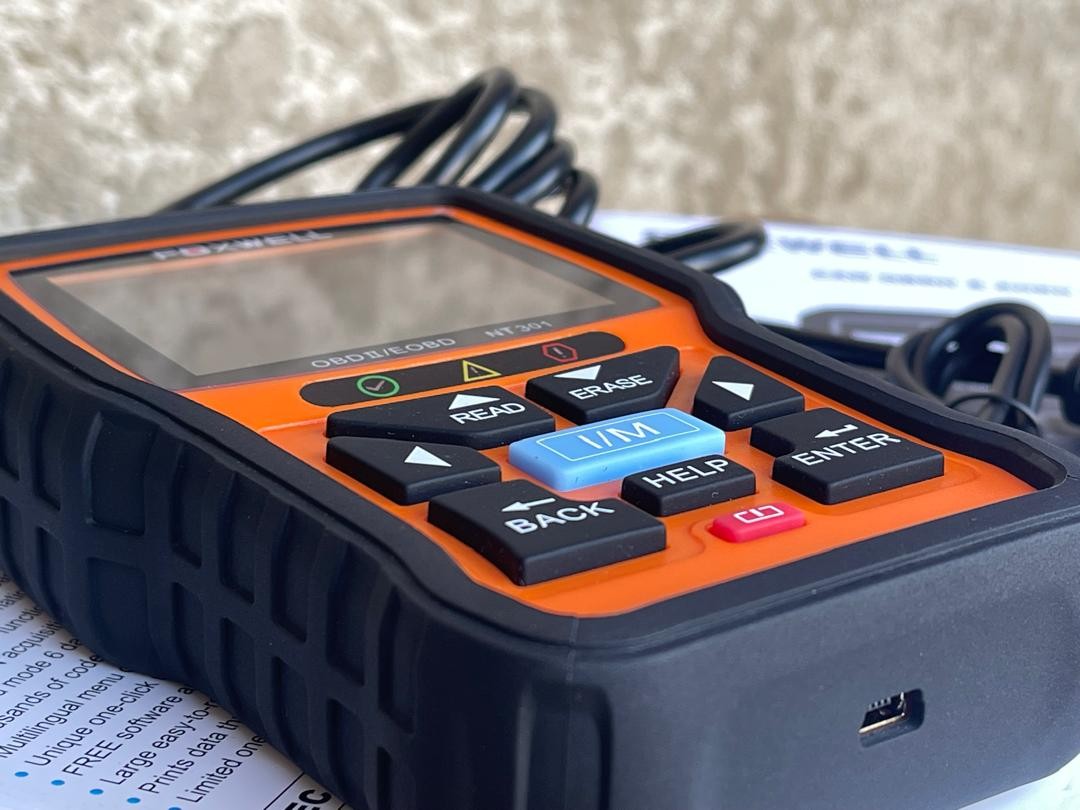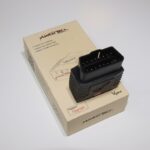For anyone venturing into the world of car diagnostics, the question “Are Foxwell Obd2 Scanners Good?” is bound to pop up. Like many, I was initially skeptical. When the Foxwell NT301 arrived for review, my first impression wasn’t exactly stellar. Having used compact scanners like the Ancel AD410, the seemingly bulkier NT301 made me wonder if it was overkill. I even jokingly thought it might just become another glove compartment gadget, barely used.
However, my initial lukewarm feelings quickly transformed into genuine admiration. Plugging the Foxwell NT301 into my car’s OBD2 port was a revelation. It wasn’t just “good”; it was surprisingly impressive. It earned its place as a valuable tool in my collection of OBD2 code readers, exceeding my expectations in ways I hadn’t anticipated.
Of course, no product is perfect. The Foxwell NT301, like any OBD2 scanner, has its pros and cons. This review aims to provide a balanced perspective, exploring the strengths and limitations of the NT301 and, by extension, addressing the broader question of whether Foxwell OBD2 scanners are indeed a worthwhile investment for car owners and DIY enthusiasts.
Let’s delve into the details and uncover what makes the Foxwell NT301 stand out, and whether it lives up to the hype surrounding Foxwell OBD2 scanners.
Foxwell NT301: Hands-On Review and First Impressions
My initial reaction to the Foxwell NT301 was admittedly mixed. Its dimensions appeared larger compared to my go-to Ancel AD410. I questioned if this size was truly necessary for a basic code reader. Despite my reservations, curiosity prevailed, and I decided to give it a fair shot.
That decision proved to be insightful. Upon physically handling the NT301, my perception shifted. It wasn’t as cumbersome as I initially imagined. The device felt comfortable in hand, manageable even with single-handed operation.
The tactile feedback of the buttons was immediately noticeable. They were soft, responsive, and offered a satisfying bounce-back, a stark contrast to the stiffer buttons of the Ancel AD410. The color display added to the premium feel. Holding the NT301, I experienced a rapid change of opinion, eager to explore its functionalities.
The packaging was simple and functional: a transparent clamshell case showcasing the NT301, accompanied by a USB update cable and a user manual. The focus was clearly on the scanner itself, not unnecessary frills.
Foxwell NT301 Functions and Capabilities: More Than Just Basic
The Foxwell NT301 is marketed as a basic OBD2 code reader. However, its performance in executing these fundamental tasks is where it truly shines. It’s not about bells and whistles; it’s about how effectively it performs core OBD2 diagnostics.
1. Effortless Code Reading and DTC Clearing
Connecting the NT301 to a vehicle’s OBD2 port is straightforward. It swiftly detects and displays OBD2 diagnostic trouble codes (DTCs) when present. Crucially, it goes beyond simply showing the code; it provides a concise description of the error.
For instance, a code like P0113 might seem cryptic to many. But the NT301 clarifies it as “Intake Air Temperature Sensor 1 Circuit High“. This immediate explanation is invaluable, providing context and direction for troubleshooting, even for users with limited technical knowledge.
Clearing codes after repairs is equally simple. The NT301 offers a dedicated button for code erasure, or the function can be accessed through the menu, offering flexibility and ease of use.
2. Dedicated Home Button: A User-Friendly Touch
A surprisingly useful feature is the dedicated “Home” button. In today’s OBD2 scanners, this is an uncommon yet highly practical addition. If you need to quickly exit a function and return to the main menu, a single press of the “Home” button does the trick.
This is a time-saver, particularly in busy garage environments or when you need to quickly restart the diagnostic process. It’s a small detail that reflects thoughtful design focused on user convenience.
3. Live Data Stream: Real-Time Vehicle Health Monitoring
Live data functionality is essential for in-depth diagnostics. Some vehicle issues, like air intake restrictions leading to fuel inefficiency, may not trigger a standard DTC immediately. Relying solely on code reading might miss these subtle problems.
Analyzing live data streams allows you to monitor sensor readings in real-time. Comparing values from sensors like the Mass Air Flow (MAF) sensor against expected parameters can pinpoint anomalies that wouldn’t be evident from DTCs alone.
For me, live data capability is a must-have in any OBD2 scanner. Fortunately, the Foxwell NT301 includes this feature, making it a valuable tool for comprehensive vehicle diagnostics.
4. Enhanced DTC Lookup with Problem Cause Insights
The NT301’s DTC lookup function goes beyond a basic code dictionary. It’s an advanced lookup tool that not only defines the DTC but also suggests potential causes for the error.
This is a significant step up from simply knowing the code definition. For DIYers and less experienced mechanics, understanding the possible reasons behind a code is incredibly helpful in guiding troubleshooting and repair efforts. It provides a more complete picture of the issue at hand.
Standout Features of the Foxwell NT301: Beyond the Basics
Beyond its core functionalities, the Foxwell NT301 incorporates several features that elevate it above typical basic code readers. These thoughtful additions contribute to its ease of use and overall value.
1. On-Screen DTC Explanations: Google Not Required
Typically, when an OBD2 scanner displays a DTC, users often resort to searching online to understand its meaning and potential causes. The Foxwell NT301 eliminates this extra step. It provides the DTC definition directly on the screen, immediately after displaying the code.
Furthermore, by pressing “ENTER,” the NT301 presents a list of likely causes for that specific DTC. This proactive approach to information delivery is incredibly beneficial, especially for users who are not deeply familiar with DTCs. It’s a smart, user-centric design that sets the NT301 apart in the realm of basic code readers. This feature should be standard in all OBD2 scanners, regardless of their complexity.
2. Dedicated Erase Button: Instant Code Clearing
While most OBD2 scanners offer code clearing functionality, the NT301’s dedicated erase button is a notable convenience. Instead of navigating through menus, you can instantly initiate code erasure with a single button press.
This is a time-saving feature, particularly useful in situations where you need to quickly clear codes. Imagine being able to clear a code while waiting at a traffic light – that’s the level of convenience this dedicated button offers.
3. Robust Protective Case: Built for Durability
OBD2 scanners often endure harsh conditions – accidental drops, greasy hands, and general wear and tear. Many scanners struggle to withstand this rough treatment, leading to premature failure.
The Foxwell NT301 addresses this with a built-in protective outer case. This soft, yet sturdy layer absorbs shocks from drops and shields the scanner from dirt and grime. This protective design is a smart move, significantly enhancing the scanner’s durability and longevity.
4. Responsive, Large Buttons: A Pleasure to Use
In the midst of car repair challenges, even small details can improve the user experience. The NT301’s large, bouncy buttons are surprisingly satisfying to use. They are soft to the touch, respond instantly when pressed, and spring back with a pleasant bounce.
This might seem like a minor detail, but in moments of frustration during diagnostics, these tactilely pleasing buttons can offer a small but welcome sense of satisfaction. It’s a subtle design element that contributes to a more positive user experience.
Foxwell NT301 Vehicle Compatibility: Broad Coverage
The Foxwell NT301 boasts broad vehicle compatibility, working seamlessly with most post-1996 vehicles I’ve tested. It consistently delivered its advertised functions, often exceeding 80% functionality across different makes and models.
However, my testing hasn’t extended to newer hybrids (including plug-in hybrids), electric vehicles, sports cars, or luxury brands like Rolls Royce. If you own one of these vehicle types, it’s advisable to directly contact Foxwell to confirm NT301 compatibility with your specific make and model before purchasing.
Foxwell NT301 Limitations: Areas for Improvement
While the Foxwell NT301 excels in many areas, it’s important to acknowledge its limitations. These aren’t necessarily deal-breakers, but awareness is key to making an informed purchase decision.
1. Non-Backlit Buttons: Visibility in Low Light
Despite the NT301’s solid construction, the buttons are not backlit. While I haven’t encountered many backlit OBD2 scanners in this category, given the NT301’s overall quality, backlit buttons would be a valuable addition, especially for use in dimly lit garages or at night.
The excellent tactile feel and responsiveness of the buttons are somewhat diminished by the lack of backlighting in low-light conditions.
2. Basic Code Reader: Limited Module Scanning
The NT301 is fundamentally a basic code reader. It doesn’t offer advanced scanning capabilities for modules beyond the engine and emissions systems, such as transmission (tranny) or ABS modules.
While these modules are generally reliable in well-maintained vehicles, the ability to scan all modules provides a more comprehensive diagnostic check. In situations where the problem is elusive, scanning all available modules can be beneficial in pinpointing the issue.
3. Cord Length: Could Be Longer
The NT301’s cable is adequately long for most vehicles and driving positions. However, after experiencing the extended cable length of the Konnwei KW850, the NT301’s cord feels somewhat shorter in comparison.
While not a major drawback, a longer cable offers greater flexibility, allowing you to operate the scanner while standing outside the vehicle, which can be convenient in certain diagnostic scenarios.
Foxwell NT301 Alternatives: Exploring Other Options
The Foxwell NT301 is a strong contender in the OBD2 scanner market. However, depending on your specific needs, alternatives might be worth considering.
If you prefer a more compact scanner, the Ancel AD410 code reader remains a reliable and pocket-friendly option. It’s been my trusted glove box scanner for years.
For users seeking more advanced features on a budget, the TopDon TopScan is an excellent choice. This compact, Bluetooth-enabled scanner offers module scanning for ABS, transmission, and more, typically found in more expensive scanners. It’s compatible with smartphones and offers a powerful diagnostic capability in a small package. Its Bluetooth connectivity adds another layer of convenience.
Final Verdict: Are Foxwell OBD2 Scanners Good? Is the NT301 Worth It?
Yes, Foxwell OBD2 scanners, particularly the NT301, are definitely good. The NT301 is a standout basic OBD2 code reader that exceeds expectations in terms of user-friendliness, functionality, and durability.
As highlighted in my Foxwell NT201 vs NT301 comparison, the NT301 demonstrates clear superiority.
While the limitations mentioned—non-backlit buttons, basic functionality, and moderate cable length—are worth considering, they are not deal-breakers for most users seeking a reliable and effective OBD2 scanner for everyday car diagnostics.
Ultimately, whether the Foxwell NT301 is the right choice for you depends on your specific needs and preferences. However, its blend of user-friendly design, essential features, and robust build quality makes it a highly recommendable OBD2 scanner in its category.
Ready to try the Foxwell NT301? Check it out directly on Amazon here.
Stay Tuned for More Automotive Insights
Throttle Lan
DIY Mechanic and Auto Writer
With half a decade of hands-on car repair experience, I’m passionate about making engines run smoothly, regardless of their origin. When I’m not under the hood, I enjoy sharing my knowledge through writing.

